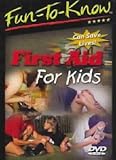Essential First Aid For Kids - What You (and They) Need To Know
First Aid for Kids
No one likes to think about their children being injured, but with kids being kids some bruises, scrapes, and occasionally worse are bound to happen. When these inevitabilities do come to pass, it’s important that you know how to treat them and how to recognize when they need more treatment than you’re going to be able to give. While many homes have basic first aid kits in them that are stocked with things such as bandages and alcohol wipes, a number of people don’t really know how to use them effectively and may not even know the true purpose of all of the items contained within.
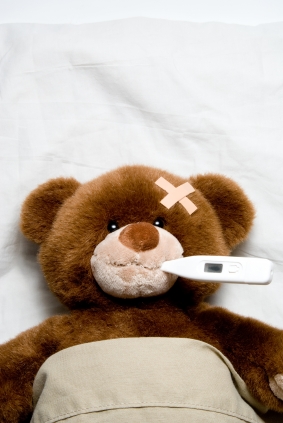
At the same time, you might have taken the time to learn the basics of first aid in case your child is injured in some way but have made no plans as to what should happen if you yourself are hurt. Children also need at least a little bit of instruction in first aid, as well as what they should do in case of an emergency if you aren’t able to take care of it yourself. This may seem like a lot to try to teach your child, but the basic information that they need to know is actually relatively easy to learn and can help to prepare your child to learn more as they continue through life.
Of course, the first aid that you should perform and the first aid that your child should know will differ depending upon their age; the younger the child is, the more likely they are for improperly-performed first aid techniques to injure them and the less likely they are to understand some of the more complex parts of performing first aid. You can begin when they reach school age by teaching them about the various parts of the first aid kit, and as they grow older and are better able to understand the differences in various injuries and emergency situations then you can teach them more as they grow.
Here are some of the things that you need to know, starting with how to keep a first aid kit stocked and up-to-date, and also the things that you should teach your child as they grow so that they’ll know what to do no matter what situation may arise.
The First Aid Kit
While it’s great that you can simply go to your local department store and purchase a pre-packaged first aid kit, many of these basic kits don’t have everything that’s needed to treat every emergency situation that arises. Obviously, these kits are designed to simply cover some of the smaller incidents that might happen around the house; no first aid kit, no matter how carefully put together, is going to be able to treat every injury or take care of every emergency. This doesn’t mean that you shouldn’t take the time to add to your basic kit or create your own from scratch, however.
First Aid Kit
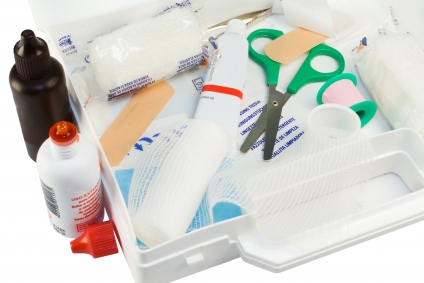
There are a variety of things which might be in a basic pre-packaged first aid kit that are useful to have… items such as latex gloves, bandages of various sizes, antibiotic ointments, alcohol wipes, burn treatments, and even mouth guards for rescue breathing are all wonderful to have stocked in your first aid kit. But even if your kit has all of these things then you still might be lacking a few items.
Add to your basic first aid kit by making sure that you have:
- an electronic thermometer (with fresh batteries)
- several nonstick sterile pads of different sizes
- clean cloth material which can be used as a compress in case of severe wounds
- eye drops or some other form of eye wash
- chemical cold and hot compresses that can be activated when needed
- an epi-pen in case of beesting allergies
- a snakebite kit
- and common over-the-counter medications such as ibuprofen or other pain relievers and fever reducers, antihistamines, anti-itch medications, and even laxatives.
You might also want to keep a few common household items with your first aid kit, such as tweezers, scissors, a flashlight (with fresh batteries), and even a clean spare blanket.
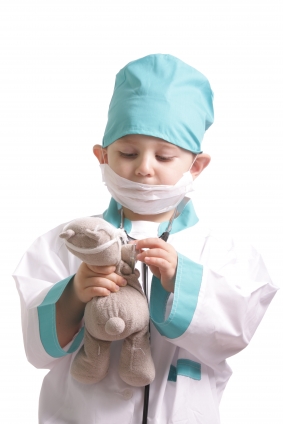
Discuss with your child the purpose of all of the items in the first aid kit, making sure that they know that it’s to be used only in case of emergencies. You should check all batteries and the expiration dates on ointments and medicines every 3-6 months, and get your child involved in the process so that they’ll know the importance of keeping the first aid kit up-to-date and well-stocked.
First Aid - Important Numbers to Know
When it comes to emergencies, you should have a list of important telephone numbers near the phone and make sure that your child knows what the numbers are for. Your list should include
- 911 (if you live in an area serviced by 911), as well as the individual numbers for
- the police department,
- the fire department,
- the closest ambulance service,
- your local poison control center,
- animal control,
- your local utility companies (such as water, gas, and electricity),
- your (and your spouse’s) work phone number,
- and the home and work numbers of nearby relatives and friends in case you or your children should have to get in touch with them during an emergency.
Emphasize the importance of this list to your child, making sure that they know that these numbers should only be called during a real emergency.
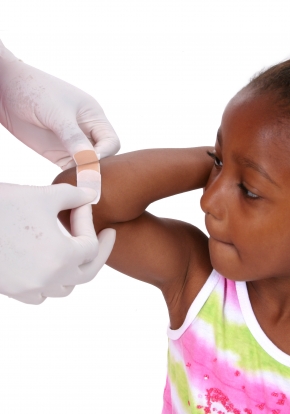
First Aid For Minor Cuts, Scrapes, and Bruises
When it comes to first aid and making sure that your children know what to do in first aid situations, the most basic injuries that will have to be treated include minor cuts, scrapes, and bruises. Generally, these sorts of injuries will require very little treatment; minor cuts and scrapes can be treated by cleaning the wound, applying an antibiotic ointment, and placing an adhesive bandage over the wound so that the bandage pad covers it completely. Bruises can be treated with the occasional application of a heating pad, though in most cases they will clear up on their own within a few days as well. Help your children to learn the proper amount of ointment to use when treating scrapes and minor cuts, or else you might end up with a bit of a mess on your hands.
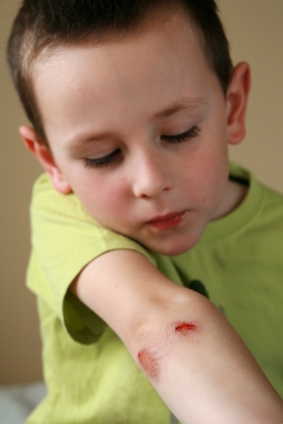
First Aid For Burns
Burns are another relatively common injury, and in many cases are treated similarly to scrapes and minor cuts. For first-degree burns (burns where the skin is pink or red, but not blistered) you can simply apply a burn cream carefully to the area and either leave it exposed to air or wrap it lightly in gauze or a nonstick sterile pad.
Second-degree burns (burns where the skin is damaged to the point of blistering) are more severe, and care should be taken not to pop the blisters as that can lead to infection. Treat the affected area as best you can with a burn cream, and then visit the doctor for professional treatment.
Should the person in question have a third-degree burn (burns with severe tissue damage), then an ambulance should be called immediately as these burns can be life threatening. Make sure that your children know the difference between the burn types, and teach them to gently treat first-degree burns once they have learned how to treat cuts and scrapes.
First Aid For Head Impact Injuries and Falls
Head impact injuries and falls can be quite serious, and there is little that you can do for the victim if they have suffered from a concussion or were seriously injured in a fall. Do your best to keep them still, especially if they feel dizzy or are suffering from any severe pains. Call an ambulance or help them to get to a doctor or emergency room in order to make sure that their injury isn’t more severe than it appears. If they claim that they feel cold or become unresponsive, cover them with a blanket to keep them warm as they may be going into shock. Teach your child to call 911 or an ambulance if you or someone else falls or hits their head and is unable to get back up or help themselves.
First Aid For Sprains and Strains
Sprains and strains can be relatively common injuries, but if not treated correctly they can cause a lot of pain and make future injuries much more likely. Ibuprofen should be given to help control swelling, and a cold compress or ice pack should be used on the site of the injury for the same reason. Only a doctor can determine the extent of the injury, so get the injured individual to a doctor as soon as possible. Most treatments will involve staying off of the injured ankle or not using the injured body part, and may also call for wrapping it in a tight bandage, keeping it elevated, and keeping ice or another cold compress on the affected area. Your child should call for an ambulance if you or someone else suffers from a sprain and are unable to get to a phone or otherwise receive assistance.
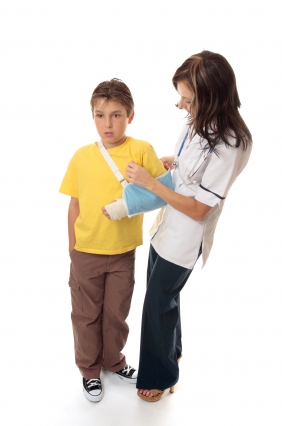
First Aid For Serious Cuts and Other Serious Injuries
Some injuries are almost beyond the scope of first aid… all that you can do is call for help immediately and try to keep the wounded person still and calm while waiting for help to arrive. In the case of severe bleeding, you should use a clean compress and put pressure on the wound in order to try to slow the bleeding; if the cut is on the leg or arm you may also put pressure higher up on the limb in order to try and restrict bloodflow to the wounded area. Broken bones and similar injuries shouldn’t be treated by someone who isn’t trained, so you should simply try to keep the injured person still. Teach your child to call for assistance if such an emergency arises, and if necessary to apply a cloth compress to a bleeding wound until help can arrive.
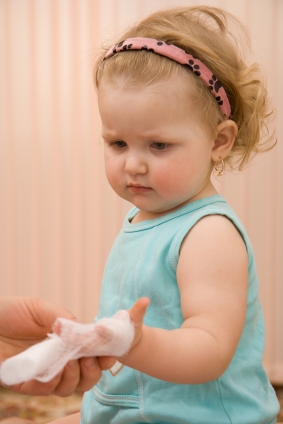
Getting the Training You Need
In order to be effective at first aid, you should try to find local first aid classes that you can attend in order to become certified and to learn the proper methods of safely dealing with emergency situations. Many localities will have children’s first aid classes that you can attend with your child as well. Certain types of first aid, such as CPR and the Heimlich Maneuver, can be dangerous if performed incorrectly so you should make sure that you attend specialized classes in order to learn them properly before attempting to use them on anyone.
This hub brought to you....
by Julie-Ann Amos, professional writer, and owner of international writing agency www.ExquisiteWriting.com
Why not create your own HubPages? It's fun and you can make revenue from Adsense and other revenue streams on your pages. JOIN HUBPAGES NOW - SIMPLY CLICK HERE... (or contact me to write one for you!)
This work is licensed under the Creative Commons Attribution-Non-Commercial-No Derivative Works 3.0 Unported License. To view a copy of this licence, visit http://creativecommons.org/licenses/by-nc-nd/3.0/ or send a letter to CreativeCommons, 171 Second Street, Suite 300, San Francisco, California94105, USA.

